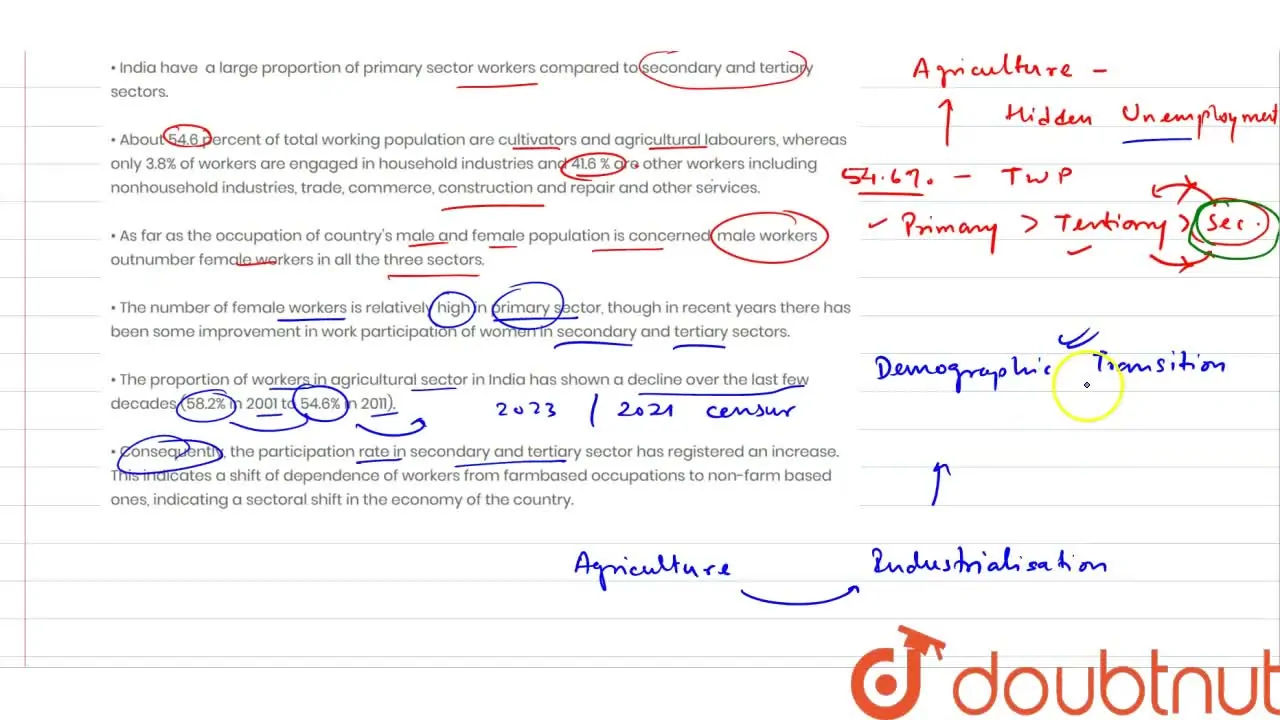Give an account of the occupational structure of India's population.
The population of India according to their economic status is divided into three groups, namely, main workers, marginal workers and non-workers. It is observed that in India, the proportion of workers (both main and marginal) is only 39 per cent (2001) leaving a vast majority of 61 per cent as non-workers. This indicates an economic status in which there is a larger proportion of dependent population, further indicating possible existence of large number of unemployed or under employed people. The occupational composition of India.s population (which actually means engagement of an individual in farming, manufacturing trade, services or any kind of professional activities) shows a large proportion of primary sector workers compared to secondary and tertiary sectors. About 58.2 per cent of total working population are cultivators and agricultural labourers, whereas only 4.2% of workers are engaged in household industries and 37.6% are other workers including non household industries, trade, commerce, construction and repair and other services. As far as the occupation of country.s male and female population is concerned, male workers out-number female workers in all the three sectors. The number of female workers is relatively high in primary sector, though in recent years there has been some improvement in work participation of women in secondary and tertiary sectors.
The participation rate in secondary and tertiary sectors has registered an increase. This indicates a shift of dependence of workers from farm-based occupations to non-farm based ones, indicating a sectoral shift in the economy of the country. The spatial variation of work participation rate in different sectors in the country is very wide. For instance, the states like Himachal Pradesh and Nagaland have very large shares of cultivators. On the other hand states like Andhra Pradesh, Chhattisgarh, Odisha, Jharkhand, West Bengal and Madhya Pradesh have higher proportion of agricultural labourers. The highly urbanised areas like Delhi, Chandigarh and Puducherry have a very large proportion of workers being engaged in other services.
Related Playlists
- BOOK - FULL MARKSCHAPTER - POPULATION : DISTRIBUTION , DENSITY , GROWTH & COMPOSITION EXERCISE - NCERT TEXTBOOK QUESTIONS SOLVED ( Answer the followingk questions in about 150 words:)1videos
POPULATION : DISTRIBUTION , DENSITY , GROWTH & COMPOSITION
- BOOK - FULL MARKSCHAPTER - POPULATION : DISTRIBUTION , DENSITY , GROWTH & COMPOSITION EXERCISE - ADDITONAL QUESTIONS SOLVED ( I. Very Short Answer Type Questions )30videos
POPULATION : DISTRIBUTION , DENSITY , GROWTH & COMPOSITION
- BOOK - FULL MARKSCHAPTER - POPULATION : DISTRIBUTION , DENSITY , GROWTH & COMPOSITION EXERCISE - WORKSHEET21videos
POPULATION : DISTRIBUTION , DENSITY , GROWTH & COMPOSITION
- BOOK - FULL MARKSCHAPTER - PLANNING AND SUSTAINABLE DEVELOPMENT IN INDIAN CONTEXT EXERCISE - WORKSHEET16videos
PLANNING AND SUSTAINABLE DEVELOPMENT IN INDIAN CONTEXT
- BOOK - FULL MARKSCHAPTER - POPULATION COMPOSITIONEXERCISE - Worksheet (Based Chapter -3)8videos
POPULATION COMPOSITION
Similar Questions
Explain with examples the occupational structure of India's population.
View SolutionGive an account of the structure of human eye.
View SolutionThe age structure of a population is its
View SolutionWhat is the annual growth rate of India's population?
View SolutionThe age structure of a population is its
View SolutionGive an account of the structure of mitochondria or plastids.
View SolutionWhat is occupational structure? Explain?
View SolutionWhat is population density?
View SolutionWhat is the occupational composition of Indian's population? Give a detailed report.
View SolutionGive an account of the Northern Plains of India.
View Solution


